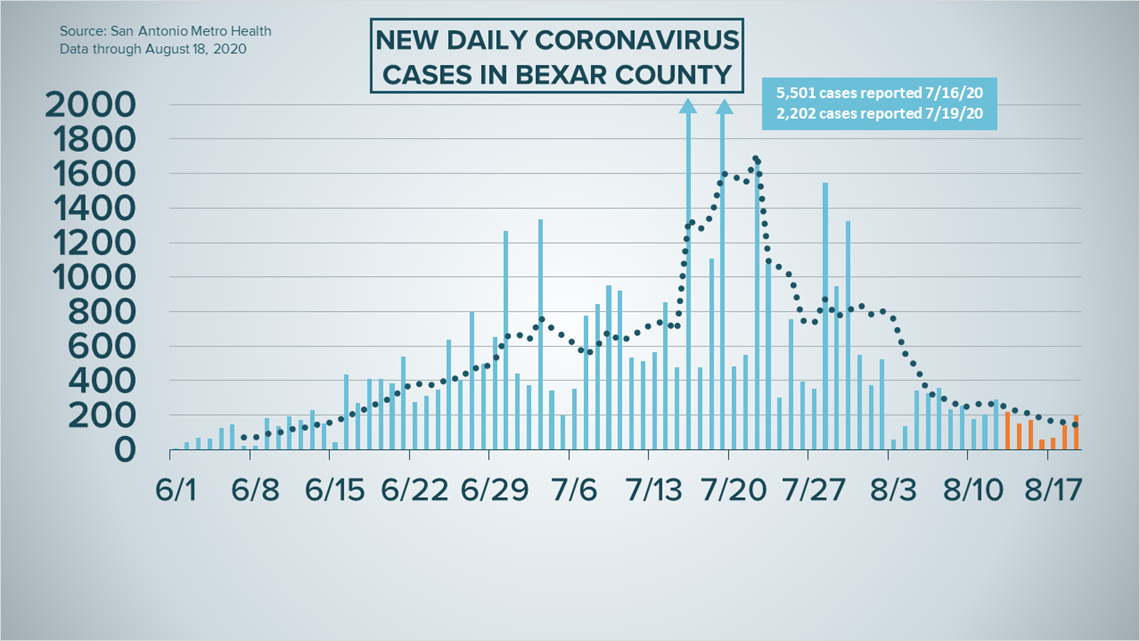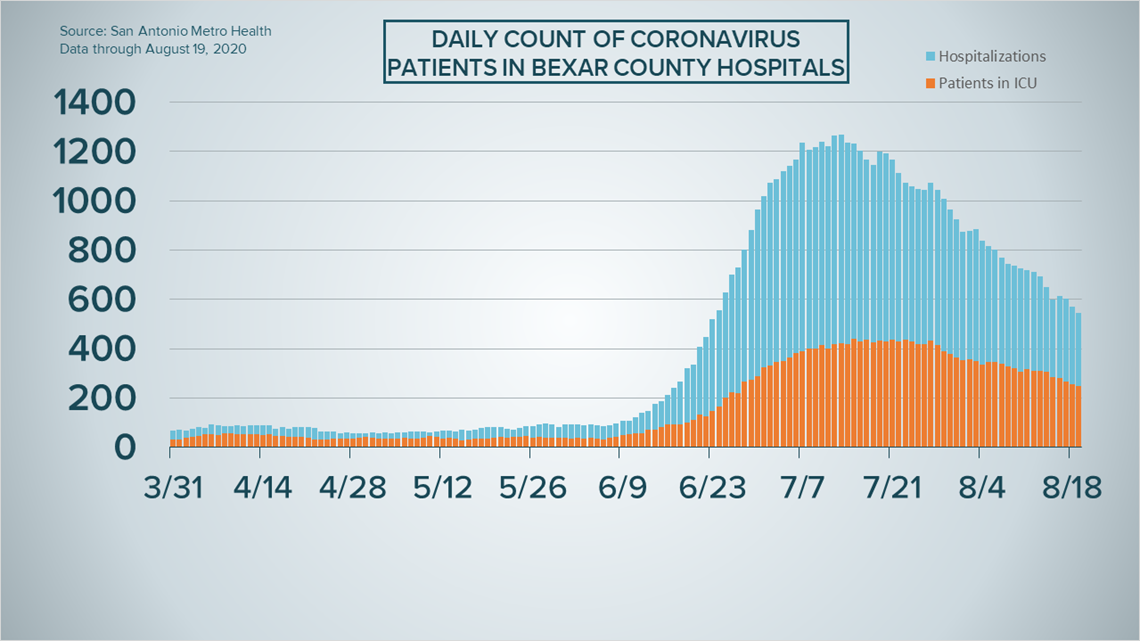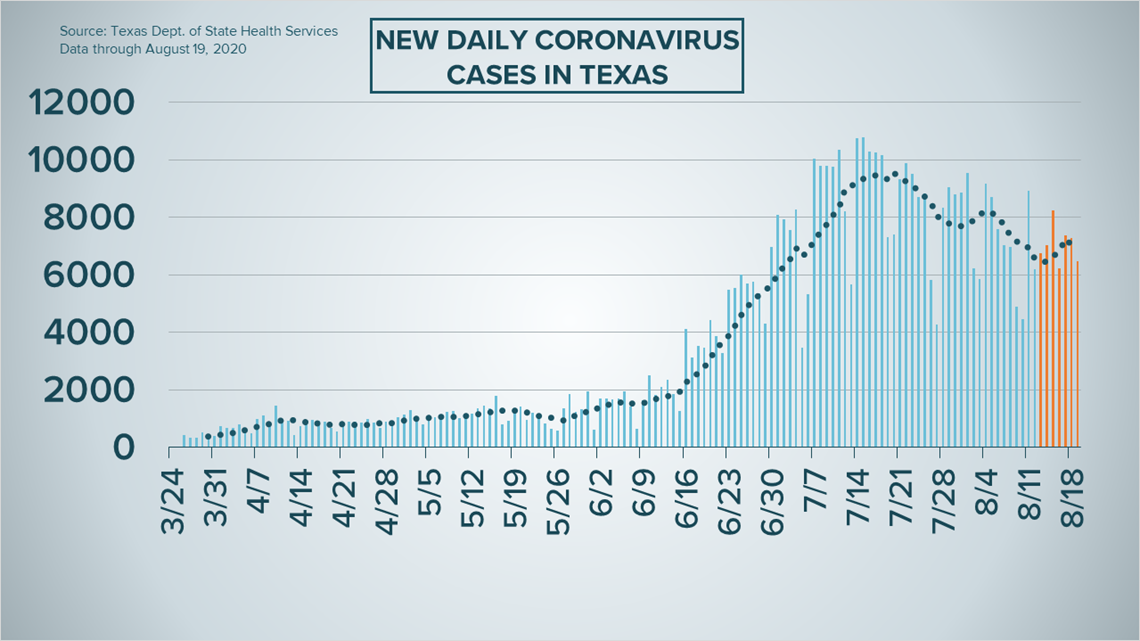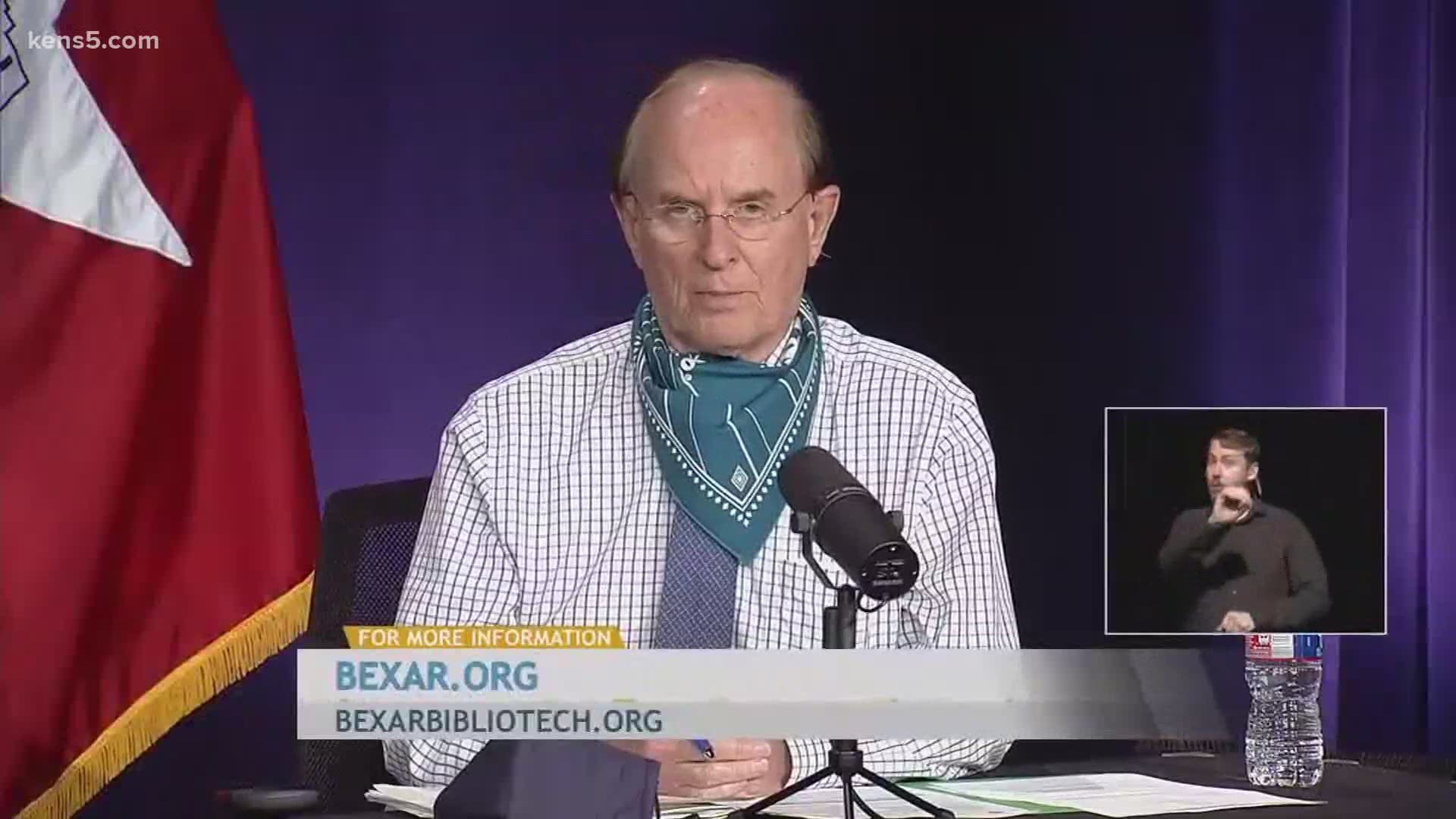SAN ANTONIO — We're tracking the latest numbers from the coronavirus pandemic in San Antonio and across Texas. Here are the latest numbers reported by Bexar and surrounding counties:
- Bexar County: 191 new cases were reported Wednesday, bringing the total number for the county to 44,456. The county death toll, meanwhile, rose to 656 after 19 additional fatalities were reported.
- Comal County: The county reported 62 new cases and five additional deaths Wednesday. There have been a total of 2,834 cases of COVID-19 in the county – including 2,256 confirmed cases – while 77 county residents have died. County officials say there are 528 active coronavirus cases, and 2,29 residents are considered recovered.
- Hays County: Officials in Hays County on Wednesday reported 18 new cases and two additional in the county. As of Wednesday evening, there were a total of 5,210 lab-confirmed cases in the county (2,518 of which are active) while the death toll has risen to 43.
How Bexar County is trending
We've tracked how many coronavirus cases have been confirmed in Bexar County from the time officials began reporting cases in March 2020. The graphic below shows the number of cases since June and charts those daily case numbers along a 7-day moving average to provide a more accurate picture of the overall coronavirus case curve in our area and the direction we're trending amid the pandemic.


On Wednesday, Mayor Ron Nirenberg reported an additional 191 cases of the novel coronavirus in Bexar County, bringing the total to 44,456.
The local death toll, meanwhile, rose to 656 after Metro Health confirmed an additional 19 deaths from COVID-19 complications. These deaths occurred between July 13 and August 17.
Hospitalizations have trended downward for nearly a month, and that trend continued on Wednesday. 546 residents were receiving treatment for virus symptoms, down from 569 on Tuesday. The number of residents on ventilators (162) and in intensive care (247) dropped slightly from Monday.
The number of coronavirus cases in children has doubled, as well as the number of children in hospitals. 3.7% of currently hospitalized patients are below the age of 18, Nirenberg reported Wednesday. That's up from 1.8% in June.


The mayor gave his weekly update on progress and warning indicators on Monday and said that the risk level in the community is now at moderate. He said that San Antonio is doing well with testing and contact tracing capacity, and the rate at which cases double is now 40 days, which is better than the target.
Hospitals are now at high stress, down from severe, with 56% of ventilators available and 14% of staffed hospital beds. The positivity rate has declined as well, but Nirenberg said the current rate of 11.3% is still much higher than the city's target of 5%.
Coronavirus in Texas
The Texas Department of State Health Services announced 6,474 new COVID-19 cases and 309 more deaths related to the coronavirus on Wednesday.
DSHS also added 550 backlogged cases to the state's overall total.
Texas now has reported 557,256 and 10,559 deaths from the virus.
The current number of people in Texas hospitals with coronavirus continues to drop. As of Wednesday, that number fell to 5,974, the lowest since June 30.
Here is the 7-day moving average for the state:


The positivity rate, which has been in question since the state updated its computer system and received several large backlogs, now sits at 10.81%.
DSHS press officer Lara Anton said Tuesday it may take through the end of the week to clear the backlogged cases, which can affect the positivity rate.
Latest Coronavirus Headlines
- Tracking COVID-19 cases at San Antonio area school districts
- North East ISD declines to post coronavirus cases on website. Here's why.
- Converse Fire Captain loses battle with coronavirus
- 'We’re being treated as guinea pigs' | Faculty members fear in-person return to Texas universities
- Pharmacists can give childhood shots in all 50 states, U.S. officials say
- If Texas was its own country, it would be #6 in COVID cases and #15 in COVID deaths, according to research from the Johns Hopkins University
Coronavirus symptoms
The symptoms of coronavirus can be similar to the flu or a bad cold. Symptoms include fever or chills, cough, shortness of breath or difficulty breathing, fatigue, muscle or body aches, headache, new loss of taste or smell sore throat, congestion or runny nose, nausea or vomiting and diarrhea, according to the Centers for Disease Control.
Most healthy people will have mild symptoms. A study of more than 72,000 patients by the Centers for Disease Control in China showed 80 percent of the cases there were mild.
But infections can cause pneumonia, severe acute respiratory syndrome, kidney failure, and even death, according to the World Health Organization. Older people with underlying health conditions are most at risk.
On June 25, the CDC expanded the list of groups at a higher risk of severe illness due to coronavirus.
Experts determined there was consistent evidence these conditions increase a person's risk, regardless of age:
- Chronic kidney disease
- COPD (chronic obstructive pulmonary disease)
- Obesity (BMI of 30 or higher)
- Immunocompromised state (weakened immune system) from solid organ transplant
- Serious heart conditions, such as heart failure, coronary artery disease, or cardiomyopathies
- Sickle cell disease
- Type 2 diabetes
The CDC believes symptoms may appear anywhere from two to 14 days after being exposed.
Human coronaviruses are usually spread...
- Between people who are in close contact with one another (within about 6 feet).
- Through respiratory droplets produced when an infected person coughs, sneezes or talks. These droplets can land in the mouths or noses of people who are nearby or possibly be inhaled into the lungs.
- Some recent studies have suggested that COVID-19 may be spread by people who are not showing symptoms.
Help stop the spread of coronavirus
- Stay home when you are sick.
- Eat and sleep separately from your family members
- Use different utensils and dishes
- Cover your cough or sneeze with your arm, not your hand.
- If you use a tissue, throw it in the trash.

